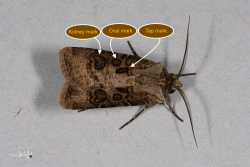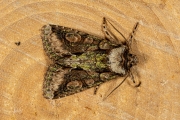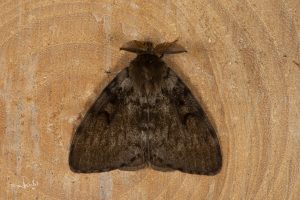If you think that you can only see butterflies and moths during the warm summer months, you’re wrong. You may have the biggest chance of seeing them fly from early spring to late autumn but some species can be found in the winter months too.
The European peacock (Aglais io) is often one of the first butterflies to emerge from its hibernation spot in spring. On certain warm November or even December days you may see this species or perhaps other species such as for example, the comma butterfly (Polygonia c-album), the brimstone (Gonepteryx rhamni) or the small tortoiseshell (Aglais urticae). These four species all overwinter as adults. As soon as it gets too cold, they look for a sheltered spot and go into hibernation mode. Why do you only see butterflies flying when it’s warm? These species need the warmth to become active, to be able to fly. So they like to warm themselves in the sun. Moths, on the other hand, can be seen almost all year round. They don’t use solar heat, but warm themselves by vibrating their wings very quickly. Just like you warm yourself up by rubbing your palms together. Moths are also much hairier than butterflies, which gives them insulation to retain their body heat. Only when the temperature approaches the freezing point, the moths give up. Only a few species like the herald (Scoliopteryx libatrix) can withstand the freezing cold and hibernate. The adults of others moth species die and these species survive the winter by overwinter as immature stages.
Wing marks
One of the moths you can see in autumn till it gets too cold (approximately under five degrees Celsius) is the green-brindled crescent (Allophyes oxyacanthae). This moth immediately stands out among all the usually brown-coloured autumn moths. Although this moth also has wings with a brown ground colour, they are not uniformly brown. The outer edge of the forewing is light coloured and there are some lighter and dark marks on the wing. These marks are characteristic for the family of moths called owlet moths (Noctuidae). The most prominent mark is often the so-called kidney mark. As the name suggests, it is shaped like a kidney (or bean). Furthermore, oval marks and sometimes tap marks (which are more rectangular) are visible. The kidney and oval mark are clearly distinguishable in many owlet moth species, the tap spot is often less so. In the photo below of a heart and club (Agrotis clavis), the three types of spots are clearly visible.
Brown and green
Okay, back to the green-brindled crescent! In addition to the light-coloured outer edge of the wing, this moth also has a very characteristic copper-green, sometimes dark green shade. This variation of brown and green makes the moth barely noticeable against a tree trunk or among the fallen leaves. Just look at the photos below. The green-brindled crescent flies from September to the end of November, sometimes even December. The eggs are deposited during this flying period. Hawthorn (Crataegus) is one of the host plants of this moth, but certainly not the most important. Blackthorn (Prunus spinosa) and birch (Betula) are the real favorites. Rowan (Sorbus) and various fruit trees also serve as host plants for the caterpillars. The eggs overwinter and the small caterpillars hatch at the end of March or beginning of April. In four to six weeks they eat their fill to become a fully grown caterpillar. It is striking that the young caterpillars are also active during the day, but the older caterpillars mainly feed at night. During the day they rest, sitting against a branch and they are almost unnoticeable.
Pre-pupal stage
Once the caterpillars have eaten their fill, they crawl into the litter layer under the trees and create a sturdy cocoon around them. What is special is that the caterpillar does not immediately pupate at that moment, as most moths and butterflies do. In case of the green-brindled crescent, pupation does not take place until about six to eight weeks later. So the caterpillar has been in the cocoon all this time. This is called the pre-pupal stage. There are more moths that do this, usually species that live as caterpillars in spring and only fly in autumn. Based on research, it is suspected that this is a strategy of the caterpillar to find another place to pupate when conditions become unfavourable. For example, if the litter layer becomes too wet due to persistent rain. The caterpillar then crawls out of the cocoon and looks for a dry place to spin another cocoon and ultimately pupate.
Beautiful, the way nature arranges this.
Sources (in Dutch):
- Vlinderstichting
- Meidoornuil op sleedoorn (Vlinderstichting)
- Waring P. en Townsend M. – Nachtvlinders, de nieuwe veldgids voor Nederland en België – Kosmos Uitgeverij – derde druk, februari 2017
- Voogd J. – Het Nachtvlinderboek – KNNV Uitgeverij – eerste druk, 2019
This blog was originally published in Dutch on November 11th 2022

















